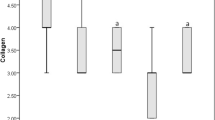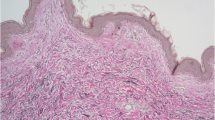Abstract
Purpose
Losartan, a commonly used angiotensin II receptor blocker (ARB) for blood pressure control, also impairs cutaneous wound healing. Our current study will analyze how Losartan affects wound healing in the muscle and fascia from both biomechanical and histological aspects.
Methods
A total of 26 Sprague–Dawley rats were separated into one control group (NS, N = 13) and one experimental group (LG, N = 13) to receive normal saline and 40 mg/kg of Losartan by way of gastric lavage, respectively. 7 days later, all animals were subjected to a 5 cm midline laparotomy. The fascia and skin were then closed with 4-0 prolene and 5-0 vicryl. 15 days postoperatively, the animals were sacrificed and the abdominal wall harvested for wound tensiometric test and histological analysis.
Results
All 26 rats survived to the time of necropsy. Tensiometry detected significantly higher wound tensile strength in the NS group (1.6 ± 0.31 N/mm) than in the LG (1.3 ± 0.28 N/mm) group (p = 0.016). Transection histology with trichrome staining demonstrated higher degree of immature fibroplasia inside the wound in the LG group than in the NS group (p = <0.0001). The LG group also had larger incisional gaps than the NG group.
Conclusion
The antihypertensive drug, Losartan, retards wound healing in the abdominal fascia and reduces wound tensile strength in our rat model. Attention should be paid to the potential effects of various medications on fascial wound healing to guarantee optimal surgical outcomes.



Similar content being viewed by others
References
Chudnovskii NA, Desnitskaia EV (1984) Optimization of the preoperative diagnosis of herniated lumbar disks. Zh Vopr Neirokhir Im N N Burdenko 6:51–56
Umakanthan R, Dubose R, Byrne JG et al (2010) Preoperative optimization of multi-organ failure following acute myocardial infarction and ischemic mitral regurgitation by placement of a transthoracic intra-aortic balloon pump. Heart Surg Forum 13(5):E342–E344
Berlauk JF, Abrams JH, Gilmour IJ et al (1991) Preoperative optimization of cardiovascular hemodynamics improves outcome in peripheral vascular surgery. A prospective, randomized clinical trial. Ann Surg 214(3):289–297 (discussion 298–9)
Buse GL, Bucher E, Seeberger MD et al (2009) Perioperative management of chronic medication: to withhold, continue or intensify? Ther Umsch 66(7):509–517
Kim S, Iwao H (2000) Molecular and cellular mechanisms of angiotensin II-mediated cardiovascular and renal diseases. Pharmacol Rev 52(1):11–34
Tang HT, Cheng DS, Jia YT et al (2009) Angiotensin II induces type I collagen gene expression in human dermal fibroblasts through an AP-1/TGF-beta1-dependent pathway. Biochem Biophys Res Commun 385(3):418–423
Dussaillant GR, Gonzalez H, Cespedes C et al (1996) Regression of left ventricular hypertrophy in experimental renovascular hypertension: diastolic dysfunction depends more on myocardial collagen than it does on myocardial mass. J Hypertens 14(9):1117–1123
Yahata Y, Shirakata Y, Tokumaru S et al (2006) A novel function of angiotensin II in skin wound healing. Induction of fibroblast and keratinocyte migration by angiotensin II via heparin-binding epidermal growth factor (EGF)-like growth factor-mediated EGF receptor transactivation. J Biol Chem 281(19):13209–13216
de Gusmao FM, Becker C, Carvalho MH et al (2005) Angiotensin II inhibition during myocardial ischemia-reperfusion in dogs: effects on leukocyte infiltration, nitric oxide synthase isoenzymes activity and left ventricular ejection fraction. Int J Cardiol 100(3):363–370
Arteel GE (2004) “HOPE” for the liver? Mechanistic insight into the role of the renin-angiotensin system in hepatic fibrosis. Hepatology 40(1):263–265
Guo L, Richardson KS, Tucker LM et al (2004) Role of the renin-angiotensin system in hepatic ischemia reperfusion injury in rats. Hepatology 40(3):583–589
Chen S, Zhou H, Wang L et al (2002) The effect of losartan intervention on the regulation of pulmonary arterial collagen expression by protein kinase C in chronic hypoxic rat models. Zhonghua Nei Ke Za Zhi 41(7):444–449
Arnold SA, Rivera LB, Carbon JG et al (2012) Losartan slows pancreatic tumor progression and extends survival of SPARC-null mice by abrogating aberrant TGFbeta activation. PLoS ONE 7(2):e31384
Viswanathan M, Saavedra JM (1992) Expression of angiotensin II AT2 receptors in the rat skin during experimental wound healing. Peptides 13(4):783–786
Ozturk CN, Tezel E, Yalcin O (2011) Evaluation of the effects of losartan on a random pattern skin flap model in rats. Ulus Travma Acil Cerrahi Derg 17(2):97–102
Biondo-Simoes Mde L, Zazula AD, Gomes AB (2006) Influence of arterial hypertension treated with losartan on skin healing in rats. Acta Cir Bras 21(3):144–150
Harth KC, Blatnik JA, Anderson JM et al (2013) Effect of surgical wound classification on biologic graft performance in complex hernia repair: an experimental study. Surgery 153(4):481–492
Franz MG (2008) The biology of hernia formation. Surg Clin North Am 88(1):1–15 vii
Franz MG, Kuhn MA, Wright TE et al (2000) Use of the wound healing trajectory as an outcome determinant for acute wound healing. Wound Repair Regen 8(6):511–516
Culbertson EJ, Xing L, Wen Y et al (2011) Loss of mechanical strain impairs abdominal wall fibroblast proliferation, orientation, and collagen contraction function. Surgery 150(3):410–417
Dubay DA, Franz MG (2003) Acute wound healing: the biology of acute wound failure. Surg Clin North Am 83(3):463–481
Dubay DA, Wang X, Kirk S et al (2004) Fascial fibroblast kinetic activity is increased during abdominal wall repair compared to dermal fibroblasts. Wound Repair Regen 12(5):539–545
Franz MG, Smith PD, Wachtel TL et al (2001) Fascial incisions heal faster than skin: a new model of abdominal wall repair. Surgery 129(2):203–208
Carlson MA (1997) Acute wound failure. Surg Clin North Am 77(3):607–636
Klinge U, Zheng H, Si ZY et al (1999) Synthesis of type I and III collagen, expression of fibronectin and matrix metalloproteinases-1 and -13 in hernial sac of patients with inguinal hernia. Int J Surg Investig 1(3):219–227
Novitsky YW, Rosen MJ (2012) The biology of biologics: basic science and clinical concepts. Plast Reconstr Surg 130(5 Suppl 2):9S–17S
Yaman I, Derici H, Kara C et al (2012) Effects of resveratrol on incisional wound healing in rats. Surg Today 5:1–6
Aren A, Gökçe A, Gökçe FS (2011) Roles of matrix metalloproteinases in the etiology of inguinal hernia. Hernia 15(6):667–671
Ren M, Hao S, Yang C et al (2013) Angiotensin II regulates collagen metabolism through modulating tissue inhibitor of metalloproteinase-1 in diabetic skin tissues. Diabetes Vasc Dis Res 10(5):426–435
CC declares no conflict of interest.
GD declares no conflict of interest.
YG declares no conflict of interest.
JY declares no conflict of interest.
HS declares no conflict of interest.
JA declares no conflict of interest.
MR declares conflict of interest not directly related to the submitted work.
YN declares conflict of interest not directly related to the submitted work.
Author information
Authors and Affiliations
Corresponding author
Electronic supplementary material
Below is the link to the electronic supplementary material.
Rights and permissions
About this article
Cite this article
Criss, C.N., Gao, Y., De Silva, G. et al. The effects of Losartan on abdominal wall fascial healing. Hernia 19, 645–650 (2015). https://doi.org/10.1007/s10029-014-1241-9
Received:
Accepted:
Published:
Issue Date:
DOI: https://doi.org/10.1007/s10029-014-1241-9




